VIETNAM
Religion

Religion
Cities in VIETNAM
| Hanoi |
Religion
General
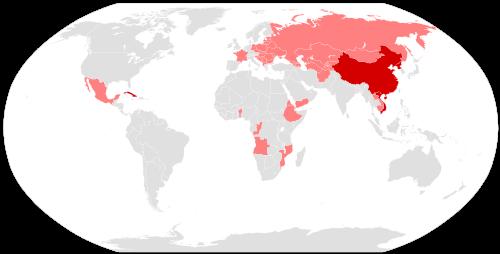 Map showing countries with state atheism, VietnamPhoto: Kamalthebest CC 4.0 International no changs made
Map showing countries with state atheism, VietnamPhoto: Kamalthebest CC 4.0 International no changs made
All religions are equal by law, but atheism plays an important role in the Republic of Vietnam, based on Marxist principles. Freedom of religion has existed since 1992, but the government does not encourage the practice of religion. Significant for this is that until 1975, as a result of the socialist regime, many monks disappeared in re-education camps. At the moment there is a clear revival of religious activities.
The three traditional and most important religions are (Mahayana) Buddhism, to which belongs approximately 55% (= 42 million adherents) of the population, Taoism and Confucianism. These three religions are mixed with animism and ancestor worship and have merged into more or less one faith, the Tam Giao or "Three Religions."
The syncretistic religion Cao Dai (literally = supreme deity) with approximately 2 million followers and the Buddhist Hoa Hao sect (variant of Hinayana Buddhism) with more than 1.5 million followers have great social influence.
Christianity is especially widespread among the mountain peoples. The Roman Catholic Church (present in Vietnam since the 17th century) has about 6 million members and is administratively organized in three archdioceses (Hanoi, Hue and Ho Chi Minh City) with a total of 21 dioceses.
There are also small minorities of Hindus and Muslims. The Muslims are mainly found among the Cham and the Khmer in the south of Vietnam. Because they had hardly any contact with other Muslims throughout history, a completely unique interpretation of Islam could develop in Vietnam. Islam was introduced in the 7th century by Arab traders and Malaysian sailors, but never really flourished in Vietnam.
Buddhism
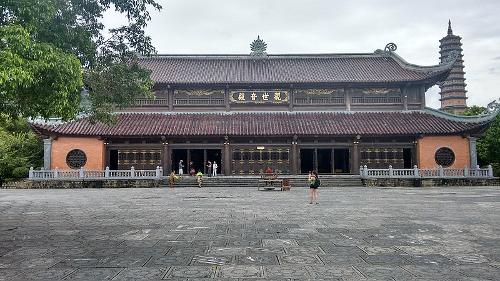 Buddhist temple in VietnamPhoto: Silveringking CC 4.0 International no changes made
Buddhist temple in VietnamPhoto: Silveringking CC 4.0 International no changes made
Buddhism originated in India in the 6th century BC. The founder was Siddharta Gautama (560-480 BC). Although it is not known exactly when Buddha was born, the year of birth is supposed to be 543 BC. The year 2013 is 2555 in the Buddhist era.
The core of Buddha's teachings are the four noble truths:
-Life is suffering.
-The cause of this suffering is desire and attachment to life. As a result, man is trapped in an unwholesome cycle of birth, death and rebirth.
-By letting go the desire and detachment man can abolish suffering.
-The eightfold path (right insight, life, striving, meditation, thinking, purpose, word and deed) is the only way out of the unwholesome cycle of reincarnation and leads to nirvana, the state of bliss.
By adhering to some basic principles man can influence his fate or "karma". The Five Commandments are: do not kill, steal, commit adultery, lie, and use alcohol, tobacco, or drugs.
Buddhism is not actually a religion, but a philosophical system and an attitude to life. There are no gods. Buddhism has monks, but again no ecclesiastical organization.
Traditionally, the king is the protector of all religions.
After Buddha's death, the religion fell apart in two directions: Mahayana Buddhism and Hinayana Buddhism.
Mahayana Buddhism is based on the universal salvation of all living beings and is therefore called the "great vehicle." This school has "bodhisattvas", mortals who have already attained enlightenment, but remain on earth to show people the right way. Mahayana Buddhism has spread across China, Nepal, Japan, Korea and also Vietnam, among others.
Mahayana Buddhism has various manifestations of Buddha and this form of Buddhism came to Vietnam via China at the beginning of our era. As a result, Mahayana Buddhism is also referred to as "Bac Tong" or "Northern Buddhism. Initially it had a profound impact on the wealthy ruling class. After the 10th century, this belief also spread among rural farmers.
Taoism
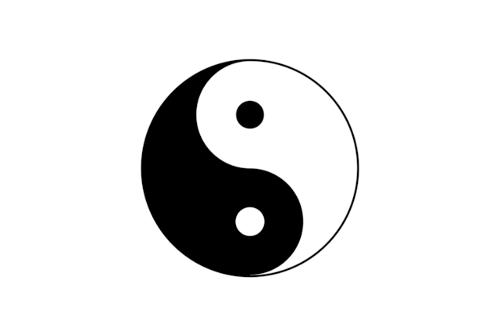 Tao Yin and Yang symbolPhoto: ChaowanGov CC 4.0 International no changes made
Tao Yin and Yang symbolPhoto: ChaowanGov CC 4.0 International no changes made
"Freedom from desires brings inner peace"
In fact, Taoism or "daojiao" is more mystical than religious, although some schools also have gods. Taoism was probably founded by Lao-tze in the 6th century BC. His ideas were recorded in the Tao Te Jing ("On the Power of the Way").
Taoism is characterized by a contemplative view of life, in which one can achieve something by not doing or "wu wei". Man must follow his own nature, without restrictions imposed from outside. It is assumed that everything arises and happens of its own accord. Taoists believe in the ordering of nature and condemn the products of civilization such as wealth, knowledge, laws and refined manners.
During its development, Taoism incorporated the yin-yang system of balanced opposites. Yin represents the feminine element, which is associated with the moon, winter, darkness, conservatism and passivity, while yang, the masculine element, is associated with the sun, summer, light, creativity and dominance.
The "Way" can also be achieved through the practice of tai chi quan, a Taoist martial art.
Taoism is the great counterpart to strict Confucian teachings. Taoism has two schools of thought: the purely philosophical doctrine "Way of the Teacher", and a more magical one, the "Cult of the Immortals". The former is very complicated and can only be understood by a select minority. The magical current was introduced to Vietnam from China around the beginning of our era. Vietnamese Taoism does not have the same hierarchy of schools and systems as Taoism in China.
Confucanism
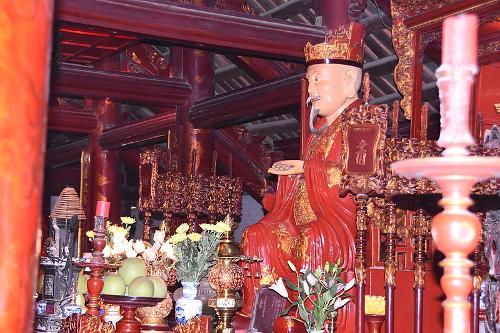 Confucius in the Temple of Literature in Hanoi, VietnamPhoto: Shankar s CC 2.0 Generic no changes made
Confucius in the Temple of Literature in Hanoi, VietnamPhoto: Shankar s CC 2.0 Generic no changes made
"A balanced combination of nature and culture gives a right attitude to life"
Confucianism or 'rujia sixiang' is named after the Chinese philosopher Confucius (551-479 BC). It is a paternalistic philosophy of society, which presents the Chinese people with the codes, rules and norms for their behavior, and Confucius (Kung Fu-tse) drew up more than 3000 rules of conduct for this.
According to Confucianism, one should not act as your heart dictates, but as your social status requires of you. General Chinese traits such as diligence, temperance, modesty and respect for the family (including great respect for the elderly) are due to Confucianism. Confucius also considered it of great importance that each individual should achieve great versatility and intelligence and be emotionally balanced. Confucius also firmly believed in the fundamental goodness of man; it is due to inadequate "understanding" (read: education) that man falls into mistakes.
Until the early 20th century, Confucianism dominated the thinking and acting of the social elite in China. It remained an important trend in a political sense as well.
Another important representative of the school founded by Confucius is Men Zi or Mencius (372-289 BC). Mencius' teachings greatly influenced Neo-Confucianism, which began during the Song Dynasty (960-1280).
Confucianism was introduced to Vietnam by the Chinese in the early 2nd century and from that time on it played an important role in Vietnamese society, especially among the ruling class. Due to the great social and political changes at the beginning of the 20th century, Confucianism lost its significance.
Hao Hao
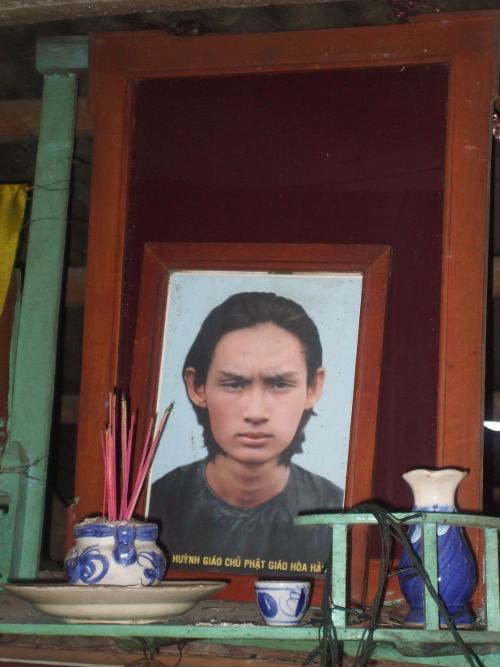 The Altar of Huynh Phu So, Hoa Hao Buddhist Priest, VietnamPhoto: Thuydaonguyen CC 3.0 Unported no changes made
The Altar of Huynh Phu So, Hoa Hao Buddhist Priest, VietnamPhoto: Thuydaonguyen CC 3.0 Unported no changes made
This sect is an offshoot of Buddhism and was founded in 1939 by the monk Huynh Phu So from southwestern Vietnam.
He argued for a return to pure Buddhism with a strong personal faith and a direct contact between man and god, without the intervention of, for example, temples and priests.
Huynh Phu So was also politically active and during World War II he worked with the Japanese occupiers. After the assassination of So in 1947, the sect began to cooperate with the French, but in 1956 President Diem put an end to the military and political power of the Hoa Hao.
The current followers of the sect now mainly live in the Mekong Delta and in the far southwest of the country.
Cao Dai
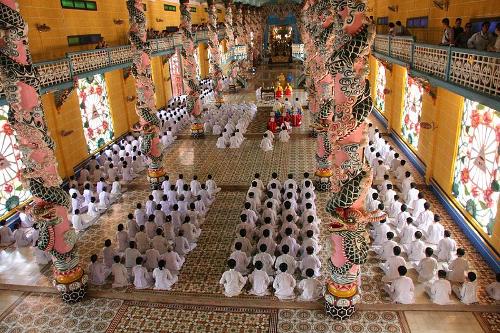 Cao Dao Monks, VietnamPhoto: Jonathan Lewis CC 2.0 Generic no changes made
Cao Dao Monks, VietnamPhoto: Jonathan Lewis CC 2.0 Generic no changes made
The belief of the Cao Dai originated in 1926, when Ngo Minh Chieu "came into contact" with Cao Dai, the Supreme Being. This urged him to combine the best of all world religions and thus a new, ideal religion should emerge. Things like spiritualism and ancestor worship were also integrated into Codaism. Mediums are used to get in touch with the supreme god Cao Dai and the spirit world.
According to the Cao Dai, human history is divided into three periods of Divine Revelation. In the first period, God revealed Himself through Lao Tze, in the second through Moses, Buddha, Confucius, Mohammed and Jesus. The period of the Cao Dai is the third and final period.
The Cao Dai have a hierarchy derived from the Catholic Church with a pope, cardinals, archbishops, bishops and priests. The lower offices are open to men and women, all clergy are celibate and vegetarian.
After the Second World War, the sect gained more political and military influence, and even had an army of 25,000 men. In 1956 the sect was disarmed by President Diem, but retained its political power. After 1975 the significance declined sharply due to government intervention, but the religious significance has increased again in recent years.
Cao Dai's followers mainly live in the Mekong Delta and in Tay Ninh province, 100 kilometers northwest of Saigon, where the main temple is also located. The symbol of the Cao Dai is the all-seeing eye and their motto is: "Dieu et Humanité, Amour et Justice" = "God and Humanity, Love and Justice".
Roman Catholicism and Protestantism
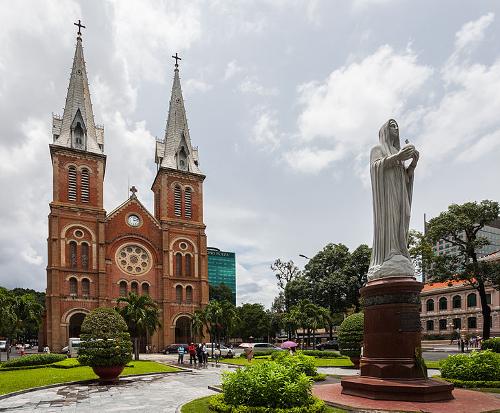 Basilica of Notre Dame, Ho Chi Minh City, Vietnam.Photo: Diego Delso CC 3.0 Unported no changes made
Basilica of Notre Dame, Ho Chi Minh City, Vietnam.Photo: Diego Delso CC 3.0 Unported no changes made
Roman Catholicism was introduced to Vietnam by the Portuguese from 1533. A century later, the French Jesuit Alexandre de Rhodes converted many Vietnamese to the Catholic faith. Initially, the Vietnamese rulers did not like the development and at one point the Catholic faith was even banned. Only under French rule did Catholicism come back strongly and in 1954 even a Catholic president, Diem.
After 1975 Catholicism had a difficult time again, but now the Church is allowed to exercise unimpeded activities as long as they are not political in nature. At the moment about 8% of the population is Catholic, after the Philippines the highest percentage of Catholics in Southeast Asia.
Protestantism was not introduced to Vietnam until the early 20th century. At the moment there are about 300,000 believers, mainly living in the central mountain region and cities in the south of the country.
Animism and Ancestor Worship
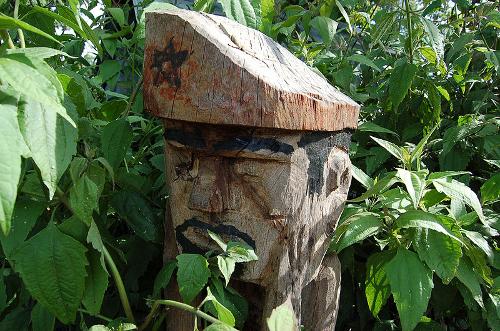 Guardian Spirit, VietnamPhoto: Rdavout CC 3.0 Unported no changes made
Guardian Spirit, VietnamPhoto: Rdavout CC 3.0 Unported no changes made
Animism still occurs mainly among the peasant population. They are often struck by forces of nature, in which they see spirits to whom they are delivered. In general, it can be said that all nature and all things are animated by good and evil spirits. They try to appease the spirits through sacrifices and worship services.
The main nature deities are Au Co, the mountain goddess, primeval father Lac Long, the dragon king, the mountain spirit Than Nui and the water spirit Than Thuy.
Every village has a guardian spirit, who lives in the temple of the Dình, the rear part of the men's community house. This spirit can be a nature god, or a revered person from myth or history. Each village chooses its own guardian spirit, which can be cast out if it does not fulfill its task properly.
Under communism, the worship of guardian spirits was forbidden, but in recent years so-called Dình parties have been held again, in which the guardian spirit is carried by the village people.
According to the Vietnamese, man has two groups of souls. The "phach" or "via" guides the body from birth to death.
The second group of souls consisting of the three "hon", is the spiritual substance that leaves the body during death. The dead are worshiped at the domestic ancestral altar by at least three generations. As a result, they remain present and even participate in family life. People communicate with their ancestors, give them paper money and gifts made of paper.
Sources
Krücker, F.-J. / Vietnam
Elmar
Paulzen, H. / Vietnam : mensen, politiek, economie, cultuur, milieu
Koninklijk Instituut voor de Tropen
Peterse, L. / Vietnam
Gottmer/Becht
Te gast in Vietnam
Informatie Verre Reizen
Vietnam
Cambium
Vietnam
Lannoo
Wulf, A. / Vietnam
Het Spectrum
CIA - World Factbook
BBC - Country Profiles
Last updated November 2025Copyright: Team The World of Info